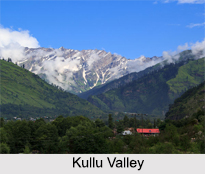 The Kullu valley is a broad open valley cradled by the Pir Panjal to the north, the Parvati Range to the east and the Bara Bhangal Range to the west. The valley is formed by the Beas River and extends up to 80 km north from the mouth of the steep and narrow Largi gorge, near Mandi, to the foot of the Rohtang Pass. The Kullu valley is famous for its roaring rivers, temples, majestic hills clad with forests of deodar, pine, sprawling apple orchards, terraced fields and snow-flecked ridges.
The Kullu valley is a broad open valley cradled by the Pir Panjal to the north, the Parvati Range to the east and the Bara Bhangal Range to the west. The valley is formed by the Beas River and extends up to 80 km north from the mouth of the steep and narrow Largi gorge, near Mandi, to the foot of the Rohtang Pass. The Kullu valley is famous for its roaring rivers, temples, majestic hills clad with forests of deodar, pine, sprawling apple orchards, terraced fields and snow-flecked ridges.
History of Kullu Valley
The Kullu Valley is referenced in the ancient Hindu literary works of Ramayana, Mahabharata and the Puranas. The name Kullu is derived from the word "Kulant Peeth", which means "end of the habitable world". During the Vedic period, several small republics known as Janapada existed. These republics were later conquered by the Nandas, the Mauryans, the Guptas and the Karkota empires as well as the Pala Dynasty. King Harshavardhana ruled the region for sometime but it was again divided into several local powers headed by chieftains, including some Rajput principalities, which were later conquered by the Maratha and the Sikh Empire.
According to Hindu legends, during the Great Flood, the first progenitor of humanity or the first man, Manu, visited this valley but was unable to cross the Rohtang Pass. Hence, the last settlement he found he named it Kulant Peeth and chose to settle and meditate there. This place where Manu meditated has now become the town of Manali or Manu"s Place.
During the Mauryan Era, Emperor Ashoka built a stupa here to mark the place where Lord Buddha had preached to the local people. This stupa was later taken away by a Mughal ruler and was put in Feroz Shah Kotla maidan in Delhi. In 634 or 635 CE, a Buddhist pilgrim monk named Xuanzang visited the Kullu valley and described it as a fertile region completely surrounded by mountains. The valley had some 20 Buddhist monasteries, with about 1,000 monks, most of whom were Mahayanists along-with some 15 Hindu temples. There were meditation caves near the mountain passes inhabited by both Buddhist and Hindu practitioners. The country is said to have produced gold, silver, red copper, crystal lenses and bell-metal.
Places of attraction in Kullu Valley
The Kullu valley has a varied biodiversity with some of the rarest animals. In order to protect the flora and fauna of this Himalayan area, many of the places are declared as wildlife sanctuaries or national parks. Along-with the parks and sanctuaries there are also other tourist attractions. Listed below are some of the popular attractions in Kullu Valley:
 The Great Himalayan National Park: Built in 1984, the park has a representative area of temperate and alpine forests of the Himachal. This national park is a habitat of numerous floras and has more than 375 animal species, which are protected under the strict guidelines of the Wildlife Protection Act of 1972. Rare animals like the Himalayan tahr, Himalayan brown bear, blue sheep, snow leopard and musk deer are found here. In 2014, the Great Himalayan National Park was added to the UNESCO list of World Heritage Site.
The Great Himalayan National Park: Built in 1984, the park has a representative area of temperate and alpine forests of the Himachal. This national park is a habitat of numerous floras and has more than 375 animal species, which are protected under the strict guidelines of the Wildlife Protection Act of 1972. Rare animals like the Himalayan tahr, Himalayan brown bear, blue sheep, snow leopard and musk deer are found here. In 2014, the Great Himalayan National Park was added to the UNESCO list of World Heritage Site.
Khokhan Wildlife Sanctuary: This sanctuary in the Kullu valley is one of the most visited sanctuaries in North India. The Khokhan Wildlife Sanctuary is home to varieties of mammals and reptiles. Animals like the Indian giant squirrel, leopard, deer, wolf and blue sheep are found here along with birds like khaleej, monal, striped parrots and pheasants of various types.
Kais Wildlife Sanctuary: The Kais Wildlife Sanctuary is spread in the Parvati Valley of the Kullu district and is known for its brown bear and the Himalayan black bear. Apart from the various types of bear, this place has a huge number of barking deer, hyena, snow leopard, Himalayan tahr, and species of birds like the monal, pheasants, peacock, western tragopan, etc.
Raison: Situated 12 km north of Kullu, Raison is a small cluster of villages on the banks of the Beas River. This place is famous for its vast camping sites. There are also a large number of orchards in this part of the valley. Devikothi and Mul Kihar are now preserved in the museum.
Katrain: Known for being the widest point in the Kullu Valley, Katrain lies at a distance of 20 km from Kullu. The Baragarh peak standing at an elevation of 3,325 metres overlooks the valley of Katrain. With the Bipasa River flowing close by, Katrain is famous for fishing.
Other areas of attraction are the Tirthan Sanctuary, Kasol, Kanawar Sanctuary, Banjar and the Rupi Baba Sanctuary.
Visiting Information on Kullu Valley
The nearest railway stations are at Kiratpur and Chandigarh on broad gauge and Jogindernagar on narrow gauge, from where Kullu can be reached by road. The Kullu-Manali Airport located in Bhuntar is at a distance of 10 km from Kullu.















